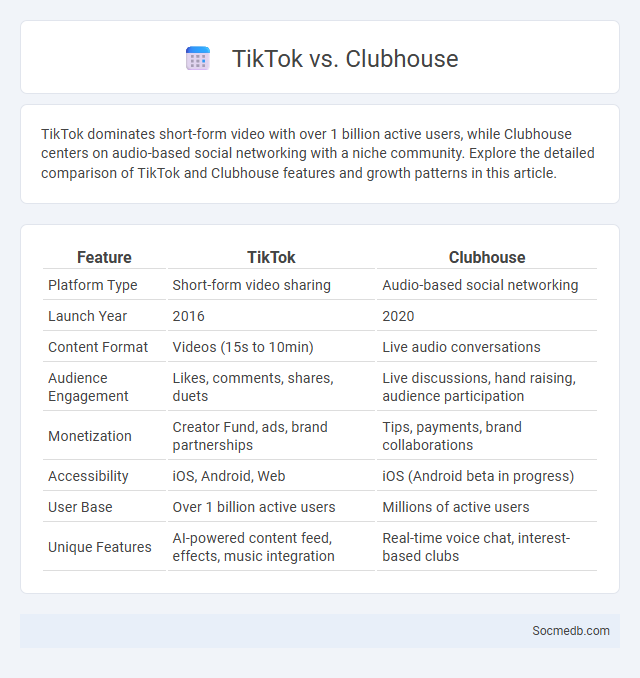
Photo illustration: TikTok vs Clubhouse
TikTok dominates short-form video with over 1 billion active users, while Clubhouse centers on audio-based social networking with a niche community. Explore the detailed comparison of TikTok and Clubhouse features and growth patterns in this article.
Table of Comparison
| Feature | TikTok | Clubhouse |
|---|---|---|
| Platform Type | Short-form video sharing | Audio-based social networking |
| Launch Year | 2016 | 2020 |
| Content Format | Videos (15s to 10min) | Live audio conversations |
| Audience Engagement | Likes, comments, shares, duets | Live discussions, hand raising, audience participation |
| Monetization | Creator Fund, ads, brand partnerships | Tips, payments, brand collaborations |
| Accessibility | iOS, Android, Web | iOS (Android beta in progress) |
| User Base | Over 1 billion active users | Millions of active users |
| Unique Features | AI-powered content feed, effects, music integration | Real-time voice chat, interest-based clubs |
Introduction: The Rise of Social Audio and Video Platforms
Social audio and video platforms have transformed digital communication by prioritizing real-time interaction and immersive content experiences. These platforms leverage advancements in streaming technology and mobile connectivity to create dynamic spaces where users engage through live conversations, video sharing, and interactive broadcasts. Your participation in these evolving social media trends can enhance personal connectivity and professional networking opportunities.
Platform Overview: TikTok vs Clubhouse
TikTok boasts over 1 billion active users globally, emphasizing short-form video content that drives high engagement through trends and challenges. Clubhouse, with a smaller user base of around 10 million, centers on live audio conversations, fostering real-time interaction and niche community building. TikTok's algorithm prioritizes content virality, while Clubhouse offers an exclusive, invite-only experience focused on voice-based networking and discussions.
User Demographics & Audience Reach
Social media platforms like Facebook, Instagram, TikTok, and LinkedIn attract distinct user demographics, with Instagram and TikTok favored by younger audiences aged 18-34, while Facebook remains popular among users aged 35-54. Audience reach varies significantly, with Facebook boasting over 2.9 billion monthly active users, Instagram exceeding 2 billion, TikTok surpassing 1 billion, and LinkedIn engaging more than 900 million professionals worldwide. Understanding these demographic trends and platform-specific user bases is essential for targeted digital marketing campaigns and maximizing engagement across diverse audiences.
Content Formats & Interactive Features
Social media platforms offer diverse content formats including short videos, stories, reels, carousels, and live streams that enhance user engagement and retention. Interactive features such as polls, quizzes, stickers, and real-time comments foster deeper audience participation and community building. These dynamic tools drive higher algorithmic visibility and increase brand interaction rates across networks like Instagram, TikTok, and Facebook.
Algorithm Differences and Content Discovery
Social media platforms use distinct algorithms that prioritize content based on user behavior, engagement patterns, and platform-specific goals, affecting how your posts are ranked and seen. Algorithms on platforms like Instagram emphasize recent interactions and content type relevance, while TikTok's algorithm focuses on content novelty and completion rates to boost visibility. Understanding these differences helps you tailor content strategies to maximize reach and improve content discovery across diverse social media channels.
Influencer Marketing Potential on Each Platform
Instagram's visual-driven format maximizes influencer marketing potential by enabling You to showcase products through stories, reels, and posts that drive high engagement rates. TikTok's algorithm promotes viral content discovery, making it ideal for influencers to rapidly expand brand reach through short, creative videos. LinkedIn offers unique B2B influencer marketing opportunities, leveraging professional credibility to influence purchasing decisions within specialized industries.
Engagement Rates and Community Building
High engagement rates on social media directly boost your brand's visibility and foster authentic connections with your audience. By consistently sharing valuable content and actively interacting with followers, you can cultivate a loyal community that supports your growth. Your strategy should prioritize meaningful conversations and user-generated content to strengthen trust and long-term relationships.
Monetization Options for Creators
Social media platforms offer diverse monetization options for creators, including ad revenue sharing, brand sponsorships, and fan subscriptions. Features such as YouTube's Partner Program, Instagram Shopping, and TikTok Creator Fund enable direct earning opportunities tied to content engagement and viewer support. Leveraging affiliate marketing and exclusive content sales further maximizes creator income streams across platforms.
Relevancy in 2024: Industry Trends & User Preferences
Social media in 2024 prioritizes relevancy through AI-driven content personalization and real-time trend analysis to enhance user engagement. Platforms like TikTok and Instagram leverage advanced algorithms to deliver niche, interest-based content, reflecting shifts in user preferences toward authenticity and value. Brands that adapt by integrating dynamic, context-aware marketing strategies experience higher interaction rates and sustained audience loyalty.
Conclusion: Choosing the Right Platform for Your Brand
Selecting the right social media platform for your brand depends on target audience demographics, content type, and engagement goals. Instagram offers visual-centric marketing ideal for lifestyle and fashion brands, while LinkedIn suits B2B companies focusing on professional networking and thought leadership. Analyzing platform user behavior and aligning it with brand messaging maximizes reach and drives meaningful interactions.
 socmedb.com
socmedb.com